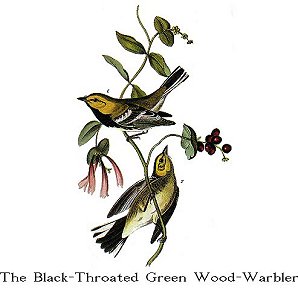
| Family VIII. SYLVICOLINAE. WOOD-WARBLERS. GENUS II. SYLVICOLA, Swains. WOOD-WARBLER. |
Next >> |

Family |
BLACK-THROATED GREEN WOOD-WARBLER. [Black-Throated Green Warbler.] |
| Genus | SYLVICOLA VIRENS, Lath. [Dendroica virens.] |
I have traced this species from the Texas to Newfoundland, although at
considerable intervals, along our Atlantic coasts, it being of rare occurrence
or wanting in some parts, while in others it is abundant; but in no portion of
the United States have I met with it so plentiful as around Eastport in Maine,
where I saw it in the month of May. Many remain all summer in that State, as
well as in Massachusetts, and the northern parts of New York; and some are found
at that season even in the higher portions of Pennsylvania. On the coast of
Labrador it was not observed by me or any of my party, and it is not mentioned
by Dr. RICHARDSON as having been seen in the Fur Countries. Its habits are
intermediate between those of many of our Warblers and the Vireos, the notes of
which latter it in a great measure assumes. It usually makes its appearance in
Maryland and New Jersey about the first week of May, when it is observed to be
actively engaged in searching for food, regardless as it were of the presence of
man. Its movements when proceeding northward are rapid, and it advances through
the woods solitarily or nearly so, it being seldom that more than two or three
are found together at this time, or indeed during the breeding season, at which
period each pair appropriates to itself a certain extent of ground. Its
retrograde march is also rapid, and by the middle of October they all seem to
have passed beyond the limits of our most southern States. The food of this
species consists during the summer months of various kinds of flies and
caterpillars, many of the former of which it captures by darting after them from
its perch, in the manner of Flycatchers and Vireos, emitting like them also a
clicking sound from its bill. In the autumn it is often seen feeding on small
berries of various sorts, in which respect also it resembles the birds just
mentioned. I never found the nest of this bird, of which, however, Mr. NUTTALL
has given a minute description, which I shall here, with his permission, place
before you. "Last summer (1830), on the 8th of June, I was so fortunate as to
find a nest of this species in a perfectly solitary situation, on the Blue Hills
of Milton. The female was now sitting, and about to hatch. The nest was in a
low, thick, and stunted Virginia juniper. When I approached near to the nest,
the female stood motionless on its edge, and peeped down in such a manner that I
imagined her to be a young bird; she then darted directly to the earth and ran,
but when, deceived, I sought her on the ground, she had very expertly
disappeared; and I now found the nest to contain four roundish eggs, white,
inclining to flesh-colour, variegated, more particularly at the great end, with
pale purplish points of various sizes, interspersed with other large spots of
brown and blackish. The nest was formed of circularly entwined fine stripes of
the inner bark of the juniper, and the tough white fibrous bark of some other
plant, then bedded with soft feathers of the Robin, and lined with a few horse
hairs and some slender tops of bent grass (Agrotis)."
My friend describes the notes of this species as follows:--"This simple,
rather drawling, and somewhat plaintive song, uttered at short intervals,
resembles the syllables 'te de' territica, sometimes tederisca, pronounced
pretty loud and slow, and the tones proceeding from high to low." These notes I
am well acquainted with, but none can describe the songs of our different
species like NUTTALL.
I have represented the male and female; the latter, I believe, has not been
hitherto figured.
BLACK-THROATED GREEN WARBLER, Sylvia virens, Wils. Amer. Orn.,
vol. ii. p. 127.
SYLVIA VIRENS, Bonap. Syn., p. 80.
BLACK-THROATED GREEN WARBLER, Nutt. Man., vol. i. p. 376.
BLACK-THROATED GREEN WARBLER, Sylvia virens, Aud. Orn. Biog.,
vol. iv. p. 70.
Outer three quills almost equal, second very slightly longer; tail slightly
emarginate. Male with the upper parts very light yellowish-green; the anterior
part of the forehead, a band over the eye, the cheeks, and the sides of the neck
bright yellow; the fore part of the neck, anterior part of the sides, and some
spots on the hind parts of the latter, black; the rest of the lower parts white,
partially tinged with yellow; quills and tail-feathers brownish-black; secondary
coverts and first row of small coverts largely tipped with white, quills
margined with greyish-white, as are the tail-feathers, of which the greater part
of the outer three, and a patch on the inner web of the fourth, are white.
Female with the upper parts similar, but with less yellow on the forehead;
ear-coverts greenish; the yellow band over the eye less bright, the yellow on
the sides of the neck of less extent; the lower parts dull yellowish-white, the
sides streaked with dusky.
Male, 4 10/12, wing, 2 1/2. Female, 4 1/2, wing, 2 (5 1/2)/12.
From Texas to Newfoundland. Abundant. Migratory.
| Next >> |